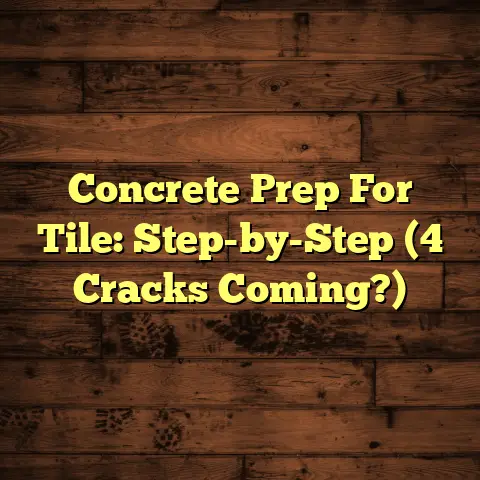Match Counters & Flooring? (1 Pro Tip!)
Forget those cookie-cutter designs. We’re moving towards personalized, cohesive spaces that maximize both aesthetics and functionality. Think sustainable materials, smart home integration, and designs that truly reflect your lifestyle. Let’s dive into how this is all shaping up, shall we?
Section 1: Understanding Match Counters
So, what exactly are match counters? Well, think of them as more than just a surface. They’re a focal point, a gathering place, and a design statement all rolled into one.
Historically, counters were purely functional – a place to prep food or serve drinks. But over time, they’ve evolved into integral parts of our living spaces.
Types of Match Counters:
-
Kitchen Islands: The classic. These offer extra prep space, seating, and storage.
-
Breakfast Bars: Perfect for casual meals and morning coffee.
-
Peninsulas: Connected to a wall, these create a semi-open feel.
-
Bathroom Vanities: Elevate the look of your bathroom with stylish and functional surfaces.
The beauty of match counters lies in their versatility. They can be adapted to fit any style, from modern minimalist to rustic farmhouse.
Materials Matter:
The material you choose for your match counter is crucial. Here are some popular options and how they complement different flooring types:
| Material | Description | Flooring Pairings |
|---|---|---|
| Granite | Durable, heat-resistant, and comes in a variety of colors. | Tile, hardwood, or luxury vinyl plank (LVP) for a sophisticated look. |
| Quartz | Engineered stone that’s non-porous and low-maintenance. | Hardwood, laminate, or polished concrete for a modern feel. |
| Butcher Block | Warm and inviting, made from solid wood. | Tile, cork, or engineered hardwood for a rustic or farmhouse vibe. |
| Concrete | Industrial-chic and highly customizable. | Polished concrete, tile, or hardwood for a contemporary space. |
| Laminate | Affordable and available in countless patterns and colors. | Laminate, vinyl, or carpet for budget-friendly designs. |
I’ve seen some amazing innovative designs lately. Think waterfall edges, integrated sinks, and even counters with built-in charging stations!
One of my favorite projects involved a kitchen island with a live-edge wood countertop paired with reclaimed wood flooring. The natural textures created a warm and inviting space that felt both modern and rustic.
Section 2: The Role of Flooring in Interior Design
Now, let’s talk flooring. It’s the foundation of any room, both literally and figuratively. It sets the tone, influences the flow, and impacts how we experience a space.
Think about it: the flooring is the first thing you feel under your feet, and it’s a large visual surface. It’s got to be right!
Flooring Options:
-
Hardwood: Timeless, durable, and adds warmth.
-
Laminate: Affordable, easy to install, and mimics the look of hardwood or tile.
-
Tile: Versatile, water-resistant, and available in endless styles.
-
Carpet: Soft, comfortable, and great for bedrooms and living rooms.
-
Luxury Vinyl Plank (LVP): Waterproof, durable, and mimics the look of hardwood or tile.
Each option has its pros and cons, of course. Hardwood is beautiful but requires more maintenance. Carpet is cozy but can stain easily. LVP is a great all-around choice for many homes.
Flooring’s Impact:
Flooring impacts everything. It influences the color scheme, the furniture choices, and even the lighting.
-
Color: Light-colored floors make a room feel bigger and brighter, while dark floors add drama and warmth.
-
Furniture: The style of your flooring should complement your furniture. For example, sleek modern furniture looks great with polished concrete or minimalist tile.
-
Lighting: Light-colored floors reflect light, while dark floors absorb it. Consider this when planning your lighting scheme.
Current Trends:
I’m seeing a huge push towards eco-friendly flooring options. Bamboo, cork, and reclaimed wood are all gaining popularity. And let’s not forget about technology! We now have flooring with built-in heating, soundproofing, and even antimicrobial properties.
Section 3: The Synergy Between Match Counters and Flooring
This is where the magic happens! The key to a truly stunning space is the synergy between your match counters and flooring. It’s about creating a cohesive look that flows seamlessly and reflects your personal style.
Complement or Contrast?
Do you want your flooring to complement your match counters, or create a bold contrast? There’s no right or wrong answer – it all depends on your personal preference.
-
Complementary: Choose flooring that’s in the same color family as your match counters. For example, a light gray quartz countertop would pair well with a light gray tile floor.
-
Contrast: Choose flooring that’s a different color or material than your match counters. For example, a dark wood countertop would pop against a light-colored concrete floor.
Color Coordination:
Color coordination is crucial. Use a color wheel to find complementary colors or create a monochromatic scheme.
-
Analogous Colors: Colors that are next to each other on the color wheel, such as blue and green.
-
Complementary Colors: Colors that are opposite each other on the color wheel, such as red and green.
-
Monochromatic: Different shades of the same color.
Texture Matching:
Don’t forget about texture! The texture of your flooring should complement the texture of your match counters.
-
Smooth Surfaces: Pair smooth countertops with smooth flooring, such as polished concrete or sleek tile.
-
Textured Surfaces: Pair textured countertops with textured flooring, such as reclaimed wood or natural stone.
Design Principles:
Keep these design principles in mind:
-
Balance: Create a sense of visual balance by distributing colors and textures evenly throughout the room.
-
Proportion: Use the right proportions to create a harmonious look. For example, a large kitchen island might require a larger tile floor.
-
Emphasis: Create a focal point by using a bold color or texture on either your match counters or flooring.
Case Studies:
I’ve worked on countless projects where the synergy between match counters and flooring truly transformed the space.
-
Modern Kitchen: A sleek white quartz countertop paired with light gray polished concrete flooring created a minimalist and modern kitchen.
-
Rustic Bathroom: A butcher block vanity with a vessel sink paired with reclaimed wood flooring created a warm and inviting rustic bathroom.
-
Contemporary Living Room: A concrete coffee table paired with dark hardwood flooring created a sophisticated and contemporary living room.
Challenges:
Achieving a seamless integration isn’t always easy. Here are some challenges designers face:
-
Structural Considerations: Ensure that the flooring can support the weight of the match counters.
-
Aesthetic Considerations: Choose colors and textures that complement each other and create a cohesive look.
-
Budget Constraints: Balance your design vision with your budget.
Section 4: Practical Tips for Homeowners
Ready to enhance your space with match counters and flooring? Here are some practical tips:
-
Measure Carefully: Measure the space accurately before ordering materials.
-
Plan Ahead: Plan the layout of the room and the placement of the match counters and flooring.
-
Consider Functionality: Choose materials that are durable and easy to maintain.
-
Consult Professionals: Don’t be afraid to consult with a designer or contractor for advice.
Installation:
-
DIY vs. Professional: Decide whether you want to install the flooring and match counters yourself or hire a professional.
-
Subfloor Preparation: Ensure that the subfloor is level and clean before installing the flooring.
-
Sealing: Seal the flooring and match counters to protect them from stains and moisture.
I always tell my clients: don’t be afraid to ask questions! A good contractor will be happy to explain the process and offer advice.
Section 5: Emerging Technologies and Innovations
The future of flooring and match counters is here! We’re seeing incredible advancements in technology and materials.
-
Smart Home Integration: Flooring with built-in sensors that can detect temperature, moisture, and even movement.
-
Sustainable Manufacturing: Flooring made from recycled materials or renewable resources.
-
Innovative Materials: Self-healing concrete, antimicrobial flooring, and countertops that change color.
Imagine a future where your flooring automatically adjusts the temperature based on your preferences, or where your countertops can repair themselves from scratches!
Potential Future Developments:
-
Customizable Flooring: Flooring that can be easily customized to fit your personal style and needs.
-
Adaptive Flooring: Flooring that can adapt to changes in your lifestyle, such as aging in place or accommodating children.
-
Interactive Flooring: Flooring that can interact with your smart home devices, such as lighting and sound systems.
Conclusion: A Vision for the Future
The integration of match counters and flooring is more than just a trend – it’s a significant shift in how we approach home design. By carefully considering the materials, colors, and textures, you can create a space that’s both beautiful and functional.
I encourage you to explore the potential of these elements in your future projects. Think about how your design choices can impact your everyday living and create a space that truly reflects your personality and lifestyle.
Pro Tip: Designing with Intent
Design with intent. It’s not just about aesthetics; it’s about creating a space that enhances your life.
Think about how your choices in match counters and flooring can influence your lifestyle.
-
Personal Style: Choose materials and colors that reflect your personal style.
-
Household Needs: Consider the needs of your household, such as children or pets.
-
Long-Term Implications: Think about the long-term implications of your design choices, such as maintenance and durability.
By designing with intent, you can create a space that’s not only beautiful but also functional, comfortable, and sustainable. Now go out there and create the home of your dreams!





